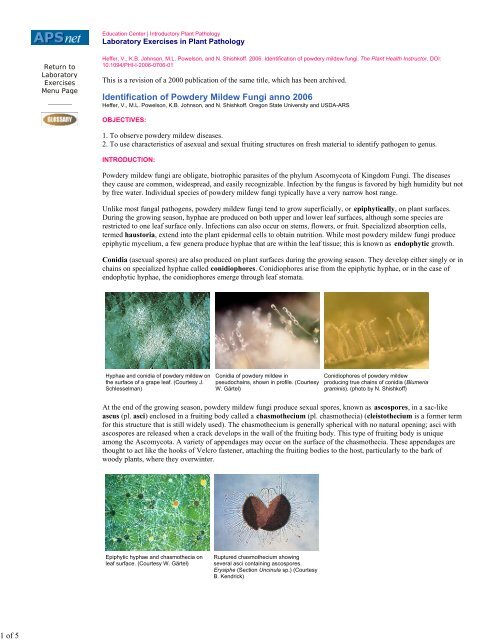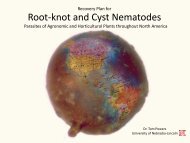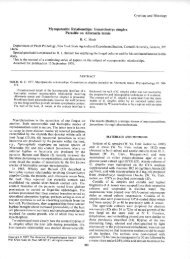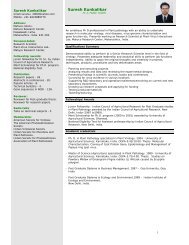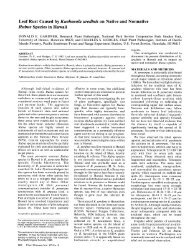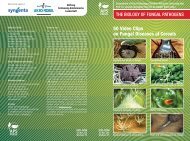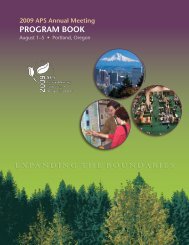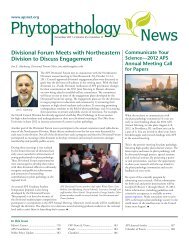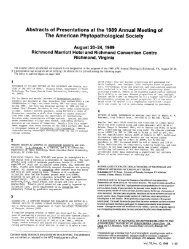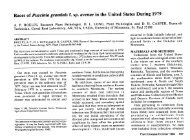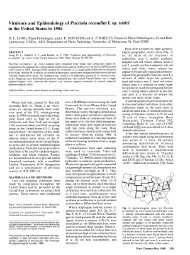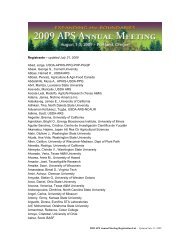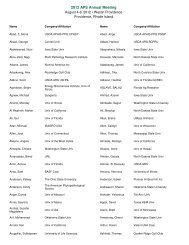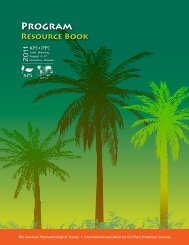Identification of Powdery Mildew Fungi - American ...
Identification of Powdery Mildew Fungi - American ...
Identification of Powdery Mildew Fungi - American ...
You also want an ePaper? Increase the reach of your titles
YUMPU automatically turns print PDFs into web optimized ePapers that Google loves.
1 <strong>of</strong> 5<br />
Return to<br />
Laboratory<br />
Exercises<br />
Menu Page<br />
Education Center | Introductory Plant Pathology<br />
Laboratory Exercises in Plant Pathology<br />
Heffer, V., K.B. Johnson, M.L. Powelson, and N. Shishk<strong>of</strong>f. 2006. <strong>Identification</strong> <strong>of</strong> powdery mildew fungi. The Plant Health Instructor. DOI:<br />
10.1094/PHI-I-2006-0706-01<br />
This is a revision <strong>of</strong> a 2000 publication <strong>of</strong> the same title, which has been archived.<br />
<strong>Identification</strong> <strong>of</strong> <strong>Powdery</strong> <strong>Mildew</strong> <strong>Fungi</strong> anno 2006<br />
Heffer, V., M.L. Powelson, K.B. Johnson, and N. Shishk<strong>of</strong>f. Oregon State University and USDA-ARS<br />
OBJECTIVES:<br />
1. To observe powdery mildew diseases.<br />
2. To use characteristics <strong>of</strong> asexual and sexual fruiting structures on fresh material to identify pathogen to genus.<br />
INTRODUCTION:<br />
<strong>Powdery</strong> mildew fungi are obligate, biotrophic parasites <strong>of</strong> the phylum Ascomycota <strong>of</strong> Kingdom <strong>Fungi</strong>. The diseases<br />
they cause are common, widespread, and easily recognizable. Infection by the fungus is favored by high humidity but not<br />
by free water. Individual species <strong>of</strong> powdery mildew fungi typically have a very narrow host range.<br />
Unlike most fungal pathogens, powdery mildew fungi tend to grow superficially, or epiphytically, on plant surfaces.<br />
During the growing season, hyphae are produced on both upper and lower leaf surfaces, although some species are<br />
restricted to one leaf surface only. Infections can also occur on stems, flowers, or fruit. Specialized absorption cells,<br />
termed haustoria, extend into the plant epidermal cells to obtain nutrition. While most powdery mildew fungi produce<br />
epiphytic mycelium, a few genera produce hyphae that are within the leaf tissue; this is known as endophytic growth.<br />
Conidia (asexual spores) are also produced on plant surfaces during the growing season. They develop either singly or in<br />
chains on specialized hyphae called conidiophores. Conidiophores arise from the epiphytic hyphae, or in the case <strong>of</strong><br />
endophytic hyphae, the conidiophores emerge through leaf stomata.<br />
Hyphae and conidia <strong>of</strong> powdery mildew on<br />
the surface <strong>of</strong> a grape leaf. (Courtesy J.<br />
Schlesselman)<br />
Conidia <strong>of</strong> powdery mildew in<br />
pseudochains, shown in pr<strong>of</strong>ile. (Courtesy<br />
W. Gärtel)<br />
Conidiophores <strong>of</strong> powdery mildew<br />
producing true chains <strong>of</strong> conidia (Blumeria<br />
graminis). (photo by N. Shishk<strong>of</strong>f)<br />
At the end <strong>of</strong> the growing season, powdery mildew fungi produce sexual spores, known as ascospores, in a sac-like<br />
ascus (pl. asci) enclosed in a fruiting body called a chasmothecium (pl. chasmothecia) (cleistothecium is a former term<br />
for this structure that is still widely used). The chasmothecium is generally spherical with no natural opening; asci with<br />
ascospores are released when a crack develops in the wall <strong>of</strong> the fruiting body. This type <strong>of</strong> fruiting body is unique<br />
among the Ascomycota. A variety <strong>of</strong> appendages may occur on the surface <strong>of</strong> the chasmothecia. These appendages are<br />
thought to act like the hooks <strong>of</strong> Velcro fastener, attaching the fruiting bodies to the host, particularly to the bark <strong>of</strong><br />
woody plants, where they overwinter.<br />
Epiphytic hyphae and chasmothecia on<br />
leaf surface. (Courtesy W. Gärtel)<br />
Ruptured chasmothecium showing<br />
several asci containing ascospores.<br />
Erysiphe (Section Uncinula sp.) (Courtesy<br />
B. Kendrick)
2 <strong>of</strong> 5<br />
The taxonomy <strong>of</strong> powdery mildew fungi (order Erysiphales) recently underwent extensive revision based on DNA<br />
sequence data. Previously, identification was based largely on the teleomorph (sexual stage) and the morphology <strong>of</strong> the<br />
chasmothecium and its appendages, but the morphology <strong>of</strong> structure is not as conserved as originally assumed. With the<br />
new taxonomy, identification <strong>of</strong> powdery mildews now also requires attributes <strong>of</strong> the anamorph (asexual stage), so that it<br />
incorporates characteristics <strong>of</strong> the whole fungus (anamorph plus teleomorph, i.e., the holomorph). <strong>Powdery</strong> mildew<br />
genera are now grouped into five tribes, and some genera have been added or merged. The chart below shows the tribes<br />
and some representative genera <strong>of</strong> each; the previous teleomorphic names (and less commonly used anamorphic names)<br />
are given to aid in reference to the older literature.<br />
Tribe New holomorphic genus<br />
Anamorphic<br />
genus<br />
Former teleomorphic genus Common Hosts<br />
Phyllactineae Phyllactinia Ovulariopsis Phyllactinia trees and shrubs<br />
Leveillula Oidiopsis Leveillula Solanaceae<br />
Erysipheae Erysiphe section Erysiphe Oidium Erysiphe section Erysiphe legumes<br />
Erysiphe section<br />
Microsphaera<br />
Oidium Microsphaera trees and shrubs<br />
Erysiphe section Uncinula Oidium Uncinula trees and shrubs<br />
Blumeriae Blumeria Oidium Blumeria/Erysiphe grasses<br />
Golovinomyceteae Golovinomyces Oidium<br />
Cystotheceae<br />
Podosphaera section<br />
Podosphaera<br />
Podosphaera section<br />
Sphaerotheca<br />
Erysiphe section<br />
Golovinomyces<br />
cucurbits and<br />
composites<br />
Oidium Podosphaera Rosaceae<br />
Oidium Sphaerotheca<br />
A major distinction for identification is whether conidia are produced in chains or singly. However, this distinction can<br />
be difficult to observe, and in some genera, particularly in the Erysipheae, conidia that are produced singly can “stick<br />
together” to form pseudochains, which are not true chains.<br />
conidiophore producing single conidium. conidiophore producing conidia in true chain. conidiophore and pseudochain.<br />
Other characteristics that aid in classification are the location <strong>of</strong> mycelium (epiphytic or endophytic) and host specificity.<br />
In addition, the presence <strong>of</strong> one or several asci in each chasmothecium can also be useful for identification. From a<br />
practical perspective, the morphology <strong>of</strong> chasmothecium appendages remains important as a connection with the older<br />
descriptions and references concerned with powdery mildew diseases.<br />
<strong>Powdery</strong> mildews are polycyclic diseases that can impair photosynthesis, stunt growth, and increase the rate <strong>of</strong><br />
senescence <strong>of</strong> host tissue. The diseases they cause may be slight or, in some situations, if left untreated, they may result<br />
in severe economic losses on crops such as apples, grapes, cucurbits, and cereals.
3 <strong>of</strong> 5<br />
MATERIALS<br />
Fresh and dried plant materials with powdery mildew signs<br />
Clear scotch tape<br />
Dissecting needles/ single-edge razor blades<br />
Microscope slides<br />
Coverslips<br />
CLICK HERE FOR INSTRUCTOR'S NOTES<br />
PROCEDURES<br />
Asexual stage<br />
With a dissecting microscope, examine the surface <strong>of</strong> a diseased leaf. Look for the presence <strong>of</strong> mycelium on the leaf<br />
surface (epiphytic growth). Genera that are partially or completely endophytic will show reduced mycelium on the<br />
surface <strong>of</strong> the leaf.<br />
Observe the leaf surface for conidia and conidiophores produced on the plant surface by epiphytic hyphae, or emerging<br />
through stomata from endophytic hyphae. Folding a section <strong>of</strong> the leaf may allow these structures to be more easily<br />
observed in pr<strong>of</strong>ile along the crease.<br />
Using a piece <strong>of</strong> clear tape (smaller than the microscope slide), hold one end <strong>of</strong> the tape and lightly smooth the rest <strong>of</strong> the<br />
tape (sticky side down) over the conidia and conidiophores. Place the tape, sticky side down, on a drop <strong>of</strong> water on the<br />
microscope slide. Observe with a compound microscope. Attempt to locate an intact conidiophore with conidia, and<br />
determine if the conidia are borne on the conidiophore singly or in chains.<br />
Sexual stage<br />
Examine fresh or dried leaves using a dissecting microscope for small black spherical structures (chasmothecia). Remove<br />
several with scotch tape (as above) or with a moistened dissecting needle or razor blade, place them in a drop <strong>of</strong> water on<br />
a microscope slide, and add a coverslip if necessary. If the slide is placed over a white sheet <strong>of</strong> paper, it is possible to see<br />
if you have successfully moved some <strong>of</strong> the (black) chasmothecia to the drop <strong>of</strong> water on the slide.<br />
Examine the chasmothecium with a compound microscope. Using the descriptions in the key below, determine the type<br />
<strong>of</strong> appendages present on the surface <strong>of</strong> the fruiting body. After observing the appendages, press gently on the coverslip<br />
or tape with the blunt end <strong>of</strong> a dissecting needle to break open the fruiting body and allow the asci to be released.<br />
Immediately examine microscopically to determine if one or several asci are contained in each chasmothecium.<br />
Use the following key and diagrams <strong>of</strong> some <strong>of</strong> the common powdery mildew genera to identify the causal agent to<br />
genus. [Note: the section name is generally the genus name in literature published before 2003.]<br />
Key to Genera <strong>of</strong> <strong>Powdery</strong> <strong>Mildew</strong> <strong>Fungi</strong><br />
Conidia formed singly<br />
Mycelium partially endophytic<br />
Chasmothecium contains several asci<br />
Appendages straight, bristle-like, with bulb-like base……….…...…..…….…..…..........Phyllactinia (A)<br />
Appendages simple, hypha-like…………………..…….………….………..…..….…….Leveillula (B)
4 <strong>of</strong> 5<br />
Conidia formed singly (or in pseudochains)<br />
Mycelium epiphytic<br />
Chasmothecium contains several asci<br />
Appendages simple, hypha-like……………………………………......Erysiphe (section Erysiphe) (C)<br />
Appendages coiled or hooked at tip..........………………......….......…Erysiphe (section Uncinula) (D)<br />
Appendages branched dichotomously at tip...………………….…Erysiphe (section Microsphaera) (E)<br />
Conidia formed in true chains<br />
Mycelium epiphytic<br />
Chasmothecium contains several asci<br />
Appendages short, simple, hypha-like; infects grasses….….………………....……………Blumeria (F)<br />
Appendages hypha-like, flexuous, simple or irregularly branched; infects dicots…......Golovinomyces (G)<br />
Conidia formed in true chains<br />
Mycelium epiphytic<br />
Chasmothecium contains a single ascus:<br />
Appendages simple, hypha-like………………..…..……..….Podosphaera (section Sphaerotheca) (H)<br />
Appendages bristle-like, branched dichotomously at tip…..…...Podosphaera (section Podosphaera) (I)
5 <strong>of</strong> 5<br />
(LAB SHEETS TO BE PRINTED AND FILLED OUT BY STUDENTS)<br />
Click here to print Lab Sheets from a separate page<br />
OBSERVATIONS<br />
Diagram the conidiophores and conidia seen on the diseased leaf.<br />
In the table below, record the location <strong>of</strong> conidiophores, the type <strong>of</strong> conidia formation, the number <strong>of</strong> asci per<br />
chasmothecium, and a description <strong>of</strong> the appendages found on the chasmothecium. Using this information, determine the<br />
pathogen genus for each powdery mildew.<br />
Plant host<br />
Conidiophores<br />
(arising from<br />
epiphytic hyphae or<br />
emerging through<br />
stomata)<br />
Conclusions and Questions<br />
Conidia formation (singly,<br />
or in chains)<br />
# <strong>of</strong> asci per<br />
chasmothecium<br />
(one or several)<br />
What physiological functions <strong>of</strong> the plant are impaired by powdery mildew fungi?<br />
What is the function <strong>of</strong> the chasmothecium in the disease cycle?<br />
What is the function <strong>of</strong> the conidia in the disease cycle?<br />
Appendage morphology Pathogen genus<br />
Why are fungal pathogens frequently assigned to more than one genera? Why is the generic name based on the<br />
holomorph (whole fungus) concept important in the powdery mildews?<br />
Speculate as to why free water on the surface <strong>of</strong> a plant might be unfavorable to a powdery mildew pathogen.<br />
Copyright © 2006<br />
by The <strong>American</strong> Phytopathological Society<br />
<strong>American</strong> Phytopathological Society<br />
3340 Pilot Knob Road<br />
St. Paul, MN 55121<br />
e-mail: aps@scisoc.org


